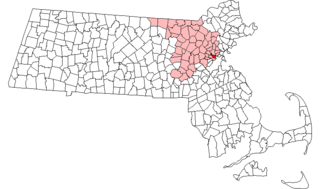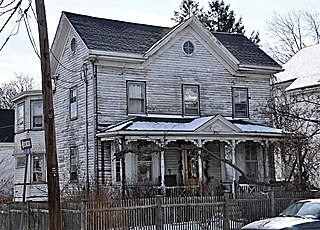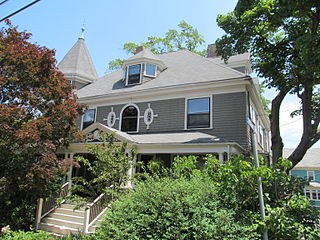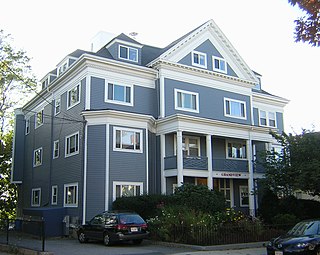
Suffield is a town in Hartford County, Connecticut, United States. The town is part of the Capitol Planning Region, and located in the Connecticut River Valley. As of the 2020 census, the population was 15,752. The town center is a census-designated place listed as Suffield Depot.

The National Register of Historic Places is a United States federal official list of places and sites considered worthy of preservation. In the state of Massachusetts, there are over 4,300 listings, representing about 5% of all NRHP listings nationwide and the second-most of any U.S. state, behind only New York. Listings appear in all 14 Massachusetts counties.

The Somerset County Courthouse is located in Somerville, the county seat Somerset County, in the U.S. state of New Jersey.

Spring Hill is the name of a ridge in the central part of the city of Somerville, Massachusetts, United States, and the residential neighborhood that sits atop it. It runs northwest to southeast, roughly bounded by Highland Avenue, Somerville Avenue, Elm Street, and Willow Avenue. Summer Street runs along the hill's crest.

This is a list of properties and historic districts in Somerville, Massachusetts, that have been listed on the National Register of Historic Places.

Powder House Square is a neighborhood and landmark rotary in Somerville, Massachusetts, United States. It is also known locally as Powder House Circle. It is the six-way intersection of College Avenue, Broadway, Warner Street, and Powder House Boulevard. Powder House Square stands at the southern tip of Tufts University's main Somerville/Medford campus, and borders the northern edge of Nathan Tufts Park. The square takes its name from the 18th century Powder House, which overlooks the rotary from Nathan Tufts Park.

The shingle style is an American architectural style made popular by the rise of the New England school of architecture, which eschewed the highly ornamented patterns of the Eastlake style in Queen Anne architecture. In the shingle style, English influence was combined with the renewed interest in Colonial American architecture which followed the 1876 celebration of the Centennial. The plain, shingled surfaces of colonial buildings were adopted, and their massing emulated.

The Flanders Historic District is a historic district that encompasses a small cluster of late-18th to early-19th century residential structures north of the center of Kent, Connecticut, United States which was the original heart of the community when it was first settled. It is centered at the junction of U.S. Route 7 with Cobble Road and Studio Hill Road. The area was supplanted by the current town center in the 1840s. The district was listed on the National Register of Historic Places in 1979.

The Old Cemetery, also known as the Milk Row Cemetery, is a historic cemetery on Somerville Avenue and School Street in Somerville, Massachusetts. Established in 1804 on land donated by Samuel Tufts, it is the city's oldest cemetery. The cemetery was established when Somerville was still a part of Charlestown, and many Somerville residents used that city's Phipps Street Burying Ground, and later the Mount Auburn Cemetery in Cambridge instead of this one. As a result, this cemetery remained small, and was the only one established within the city limits in the 19th century.

The former First Unitarian Church is a historic church building at 130 Highland Avenue in Somerville, Massachusetts. The stone church was built in 1894 for a Unitarian congregation. It was designed by Hartwell & Richardson and is a good example of Richardsonian Romanesque design. The building presently (2022) houses the Mission Church of Our Lord Jesus Christ.

The Charles Williams Jr. House, built in 1858, is a historic house in Somerville, Massachusetts. Charles Williams Jr. was a manufacturer of electrical telegraph instruments at 109 Court Street in Boston. Alexander Graham Bell and Thomas A. Watson experimented with the telephone in Williams' shop, and it was there that they first heard indistinct sounds transmitted on June 2, 1875. The first permanent residential telephone service in the world was installed at this house in 1877, connecting Williams' home with his shop on Court Street in Boston. Williams had telephone Numbers 1 and 2 of the Bell Telephone Company.

The Elisha Hopkins House is a historic house in Somerville, Massachusetts. The 2.5-story wood-frame house was built c. 1868 by Elisha Hopkins, a ship's master. It has a typical period Italianate plan, with three bays across and small center gable. The gables have oculi windows characteristic of the style, and there is a later Colonial Revival front porch with turned posts and brackets, and a gable over the entry stair.

The House at 16–18 Preston Road in Somerville, Massachusetts is one of the city's finest Colonial Revival multiunit houses. The three-story wood-frame house was built c. 1910. It has a flat roof with projecting eaves, and a modillioned cornice. The front facade has a two-story porch, with each level supported by clusters of colonettes. The house was built on the site of a former apple orchard owned by George Ireland; the street is named for Ireland's wife, Jane Preston Ireland.

The house at 49 Vinal Avenue in Somerville, Massachusetts is a stylish combination of Colonial Revival and Shingle styling. The 2+1⁄2-story wood-frame house was built c. 1894. It has a wide gambrel roof with cross gables that are also gambreled. The front cross gable is flanked by two hip roof dormers whose windows are flanked by pilasters and topped by an entablature with wooden garlands and dentil molding. The house is clad in wavy cut shingles, and its windows are topped by tall entablatures. It has a porch running the width of the front facade that is uncovered except for a portico sheltering the front door.

The house at 72R Dane Street in Somerville, Massachusetts is one of Somerville's oldest surviving structures and is located near the site of the earliest settlement in Somerville.

The Joseph K. James House is a historic house at 83 Belmont Street in Somerville, Massachusetts. This 3 story wood-frame house was built in 1893-4 for Joseph Knightley James, a partner in a local soap manufacturer. It is one of Somerville's best examples of Queen Anne and Colonial Revival styling. It has a rectangular Colonial Revival form with a pitched hip roof, with a Queen Anne turret and chimney tops. The front porch is supported by clusters of columns and features a pedimented gable over the entry that is decorated with a hand-carved lion's head surrounded by a floral design.

The Martin W. Carr School is a historic school building located at 25 Atherton Street, in the Spring Hill area of Somerville, Massachusetts. Built in 1898, it is a prominent local example of Colonial and Renaissance Revival architecture, and the only known surviving work of local architect Aaron H. Gould. It served the local neighborhood as a school until 1980, and was subsequently converted into condominiums. It was listed on the National Register of Historic Places in 1984.

The Philemon Russell House is a historic house in Somerville, Massachusetts. Philemon Robbins Russell was a farmer who owned 50 acres (20 ha) of apple orchards near Russell Street. This land was converted to house lots for development by Captain Gilman Sargent in 1845 creating Orchard Street, Russell Street and Cottage Place. His house, built 1845, is one of the best-preserved side-hall Greek Revival farmhouses in the city. It was moved to the current location from somewhere else. According to the Somerville Journal, page 6, a fire occurred that badly damaged the upper portion of the house. The cause was a mystery and the estimated damage was $2,000. The Boston Daily Globe reported the first took place on On February 26, 1905.

The Grandview is a historic apartment hotel at 82 Munroe Street in Somerville, Massachusetts. This type of building was not uncommon in the city at the time of its 1896 construction. This building affords commanding views of the Boston area from its site near the top of Prospect Hill, and has well-preserved Colonial Revival styling. The building was listed on the National Register of Historic Places in 1989.

Forest Park is a Victorian garden district located in Springfield, Massachusetts, developed between 1880 and 1920. It is the city's most populous neighborhood, and surrounds the 735-acre Forest Park, for which the neighborhood is named. The Forest Park neighborhood has nature and recreation within walking distance. To the west, I-91 separates Forest Park from the Connecticut River. A 195-acre section of the neighborhood was listed on the National Register of Historic Places in 1982 as the Forest Park Heights Historic District.























